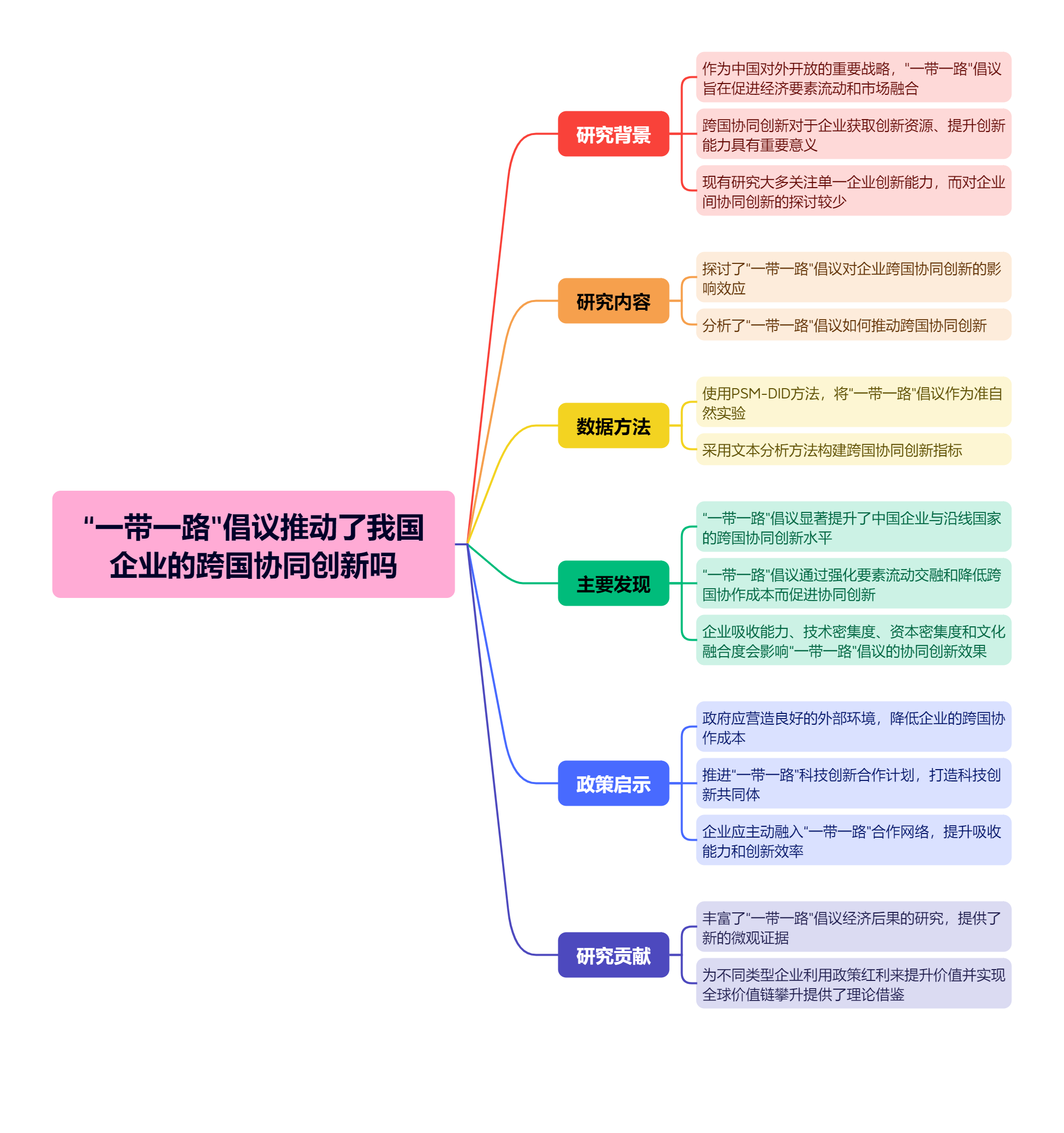在高水平对外开放的新格局下,跨国协同创新成为培育新兴产业发展动能和实现经济高质量发展的重要途径。文章突破了现有研究关注“一带一路”倡议对单一企业创新能力影响的局限,将视角转换为我国企业与“一带一路”共建国家的合作共赢。文章基于2010—2020年我国A股上市公司数据,将“一带一路”倡议作为一项准自然实验,使用PSM-DID方法,考察了“一带一路”倡议对跨国协同创新的影响及其作用机制和应用情境。研究发现,“一带一路”倡议通过“强化要素流动交融”和“降低跨国协作成本”两种效应,有效推动了我国企业与沿线国家的跨国协同创新。异质性分析发现,当企业吸收能力较强、属于技术密集型和资本密集型产业以及与沿线国家的文化融合度较高时,“一带一路”倡议对企业跨国协同创新的推动效应更加显著。进一步研究发现,“一带一路”科技创新合作计划的出台显著强化了“一带一路”倡议对跨国协同创新的推动效应。文章为我国企业与“一带一路”共建国家进行跨国协同创新的驱动机制提供了理论参考与实践证据,也为企业如何借助政策的力量实现跨国协同合作和实现高质量发展提供了重要的启示。
“一带一路”倡议推动了我国企业的跨国协同创新吗?
摘要
参考文献
相关附件
思维导图
8 江小涓,孟丽君. 内循环为主、外循环赋能与更高水平双循环——国际经验与中国实践[J]. 管理世界,2021,(1):1−18. DOI:10.3969/j.issn.1002-5502.2021.01.001
12 刘斐然. 市场竞争、政府支持与产学研合作创新[J]. 现代经济探讨,2022,(5):88−98. DOI:10.3969/j.issn.1009-2382.2022.05.009
28 Barro R J,McCleary R M. Religion and economic growth[J]. American Sociological Review,2003,68(464):9682.
29 Chesbrough H W. Open innovation:The new imperative for creating and profiting from technology[M]. Boston:Harvard Business School Press,2003.
30 Cohen W M,Levinthal D A. Innovation and learning:The two faces of R&D[J]. The Economic Journal,1989,99(397):569−596. DOI:10.2307/2233763
31 Dahlander L,Gann D M. How open is innovation?[J]. Research Policy,2010,39(6):699−709. DOI:10.1016/j.respol.2010.01.013
32 Du J L,Zhang Y F. Does one belt one road initiative promote Chinese overseas direct investment?[J]. China Economic Review,2018,47:189−205. DOI:10.1016/j.chieco.2017.05.010
33 Gao Y. Influences of institutional differences on Chinese enterprises’ investment on countries in “the belt and road” strategy-based on regulatory effects of ethnic Chinese in host countries[J]. Modern Economy,2017,8(4):551−566. DOI:10.4236/me.2017.84042
34 Hsu C W,Lien Y C,Chen H. R&D internationalization and innovation performance[J]. International Business Review,2015,24(2):187−195. DOI:10.1016/j.ibusrev.2014.07.007
35 Huang Y P. Understanding China’s belt & road initiative:Motivation,framework and assessment[J]. China Economic Review,2016,40:314−321. DOI:10.1016/j.chieco.2016.07.007
36 Kim L. Crisis construction and organizational learning:Capability building in catching-up at hyundai motor[J]. Organi- zation Science,1998,9(4):506−521. DOI:10.1287/orsc.9.4.506
37 Kyläheiko K,Jantunen A,Puumalainen K,et al. Innovation and internationalization as growth strategies:The role of technological capabilities and appropriability[J]. International Business Review,2011,20(5):508−520. DOI:10.1016/j.ibusrev.2010.09.004
38 Li J J,Poppo L,Zhou K Z. Relational mechanisms,formal contracts,and local knowledge acquisition by international subsidiaries[J]. Strategic Management Journal,2010,31(4):349−370. DOI:10.1002/smj.813
39 Lichtenthaler U. Open innovation:Past research,current debates,and future directions[J]. Academy of Management Perspectives,2011,25(1):75−93.
40 Reus T H,Lamont B T. The double-edged sword of cultural distance in international acquisitions[J]. Journal of International Business Studies,2009,40(8):1298−1316. DOI:10.1057/jibs.2009.25
41 Romer P M. Endogenous technological change[J]. Journal of Political Economy,1990,98(5):S71−S102. DOI:10.1086/261725
42 Smarzynska B K. Does foreign direct investment increase the productivity of domestic firms? In search of spillovers through backward linkages[R]. Policy Research Working Papers 2923,2002.
43 Wu J,Wang C Q,Hong J J. Internationalization and innovation performance of emerging market enterprises:The role of host-country institutional development[J]. Journal of World Business,2016,51(2):251−263. DOI:10.1016/j.jwb.2015.09.002
44 Zahra S A,George G. Absorptive capacity:A review,reconceptualization,and extension[J]. The Academy of Management Review,2002,27(2):185−203. DOI:10.2307/4134351
引用本文
黄宏斌, 李圆圆, 许晨辉. “一带一路”倡议推动了我国企业的跨国协同创新吗?[J]. 财经研究, 2024, 50(6): 108-122.
导出参考文献,格式为:





 3840
3840  5856
5856


